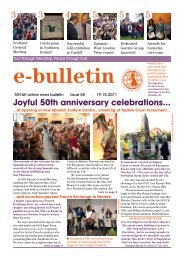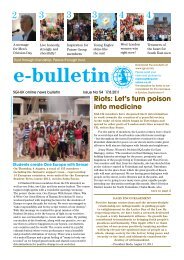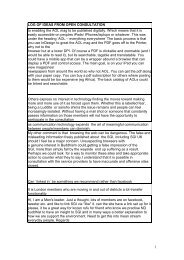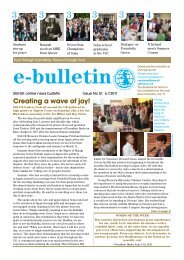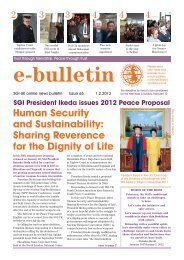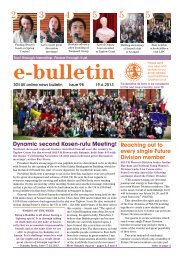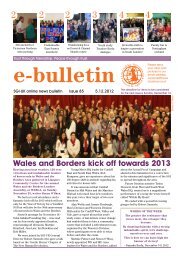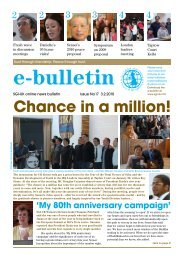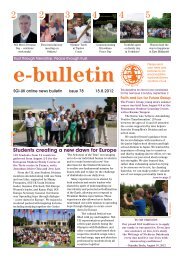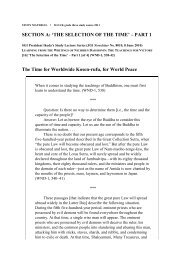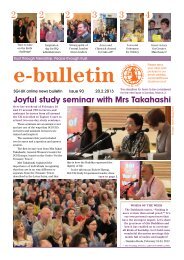SECTION A: 'THE SELECTION OF THE TIME' – PART 2 The Age of ...
SECTION A: 'THE SELECTION OF THE TIME' – PART 2 The Age of ...
SECTION A: 'THE SELECTION OF THE TIME' – PART 2 The Age of ...
Create successful ePaper yourself
Turn your PDF publications into a flip-book with our unique Google optimized e-Paper software.
STUDY MATERIAL SGI-UK grade three study course 2011<br />
<strong>SECTION</strong> A: ‘<strong>THE</strong> <strong>SELECTION</strong> <strong>OF</strong> <strong>THE</strong> TIME’ <strong>–</strong> <strong>PART</strong> 2<br />
SGI President Ikeda’s Study Lecture Series (SGI Newsletter No. 8047, 4 August 2010)<br />
LEARNING FROM <strong>THE</strong> WRITINGS <strong>OF</strong> NICHIREN DAISHONIN: <strong>THE</strong> TEACHINGS FOR VICTORY<br />
[17] ‘<strong>The</strong> Selection <strong>of</strong> the Time’ <strong>–</strong> Part 2 [<strong>of</strong> 4] (WND-1, 543-52)<br />
<strong>The</strong> <strong>Age</strong> <strong>of</strong> the Buddhism <strong>of</strong> the People, an <strong>Age</strong> <strong>of</strong> Human<br />
Triumph<br />
Now more than two hundred years have passed since we entered the<br />
Latter Day <strong>of</strong> the Law, a time <strong>of</strong> which, as the Great Collection Sutra<br />
records, the Buddha predicted that “quarrels and disputes will arise<br />
among the adherents to my teachings, and the pure Law will become<br />
obscured and lost.” If these words <strong>of</strong> the Buddha are true, it is a time<br />
when the whole land <strong>of</strong> Jambudvipa [the entire world] will without<br />
doubt be embroiled in quarrels and disputes. . . .<br />
[T]he Buddha’s prediction concerning the occurrence <strong>of</strong> quarrels<br />
and disputes has proved anything but false. It is like the tides <strong>of</strong> the<br />
ocean that never fail to come when the time arrives.<br />
In view <strong>of</strong> the accuracy <strong>of</strong> his prediction, can there be any doubt<br />
that, after this period described in the Great Collection Sutra when<br />
“the pure Law will become obscured and lost,” the great pure Law <strong>of</strong><br />
the Lotus Sutra will be spread far and wide throughout Japan and all<br />
the other countries <strong>of</strong> Jambudvipa? (WND-1, 549<strong>–</strong>50)<br />
***<br />
[In the Lotus Sutra, Many Treasures Buddha and the Buddhas <strong>of</strong> the<br />
ten directions testified to the truth <strong>of</strong> Shakyamuni’s teaching.]<br />
Shakyamuni Buddha also extended his tongue, which is incapable <strong>of</strong><br />
telling falsehoods, until it reached the highest heaven in the world <strong>of</strong><br />
form, saying that in the last five-hundred-year period after his<br />
passing, when the entire body <strong>of</strong> Buddhist doctrine would be about to<br />
disappear, Bodhisattva Superior Practices would come forward with<br />
the five characters <strong>of</strong> Myoho-renge-kyo and administer them as good<br />
medicine to those afflicted with white leprosy—that is, persons <strong>of</strong><br />
incorrigible disbelief and those who slander the Law. And he charged<br />
Brahma, Shakra, the gods <strong>of</strong> the sun and moon, the four heavenly
kings, and the dragon deities to act as that bodhisattva’s protectors.<br />
How could these golden words <strong>of</strong> his be false? Even if the great earth<br />
were to turn upside down, a high mountain crumble and fall, summer<br />
not follow spring, the sun move eastward, or the moon fall to earth,<br />
this prediction could never fail to come true! (WND-1, 550)<br />
***<br />
A person who spreads the Lotus Sutra is father and mother to all the<br />
living beings in Japan. For, as the Great Teacher Chang-an says,<br />
“One who rids the <strong>of</strong>fender <strong>of</strong> evil is acting as his parent.” If so, then<br />
I, Nichiren, am the father and mother <strong>of</strong> the present emperor <strong>of</strong><br />
Japan, and the teacher and lord <strong>of</strong> the Nembutsu believers, the Zen<br />
followers, and the True Word priests. (WND-1, 551)<br />
Lecture<br />
My mentor, second Soka Gakkai president Josei Toda, declared: “<strong>The</strong> time is more<br />
than ripe. Seven centuries have passed since Nichiren Daishonin proclaimed his<br />
teaching. Nowhere in the course <strong>of</strong> those 700 years until now has there been an<br />
organization like the Soka Gakkai. I hope you will take great pride in this.” 1 With this<br />
powerful lion’s roar, he underscored the extraordinary nature <strong>of</strong> our organization,<br />
which had appeared in modern times to carry out the momentous mission <strong>of</strong> realizing<br />
the Buddha’s decree <strong>of</strong> the widespread propagation <strong>of</strong> the Mystic Law.<br />
Overcoming wartime persecution and the painful struggles to rebuild the<br />
organization after the war, Mr. Toda spearheaded the dynamic development <strong>of</strong> our<br />
movement as a great leader and teacher <strong>of</strong> propagation. He was motivated by a<br />
pr<strong>of</strong>ound determination to rid the world <strong>of</strong> misery.<br />
“If the Buddha’s words are true, then kosen-rufu can definitely be achieved. <strong>The</strong><br />
time to propagate the Mystic Law has arrived! <strong>The</strong> happiness <strong>of</strong> humanity hinges on<br />
the efforts we make now for kosen-rufu”—this was his unwavering conviction.<br />
Opening the Path <strong>of</strong> Worldwide Kosen-rufu<br />
Mr. Toda <strong>of</strong>ten said: “We mustn’t miss this chance!” Boldly deciding that the time for<br />
kosen-rufu had come, he devoted himself to laying the foundations for kosen-rufu in<br />
Japan. And he entrusted me, his loyal disciple, with the great mission <strong>of</strong> realizing the<br />
1 From Josei Toda’s speech at his inauguration as second president <strong>of</strong> the Soka Gakkai on May 3,<br />
1951.<br />
2
Daishonin’s vision <strong>of</strong> the westward transmission <strong>of</strong> Buddhism 2 —that is to say,<br />
worldwide kosen-rufu.<br />
“Daisaku, I’ll build a solid foundation for kosen-rufu in Japan. You must open the<br />
way for kosen-rufu throughout the world. I’m counting on you!”—this solemn wish <strong>of</strong><br />
my mentor has never left my mind for even a moment. This is because, for me, as heir<br />
to Mr. Toda’s spirit, worldwide kosen-rufu represents the shared vow <strong>of</strong> mentor and<br />
disciple and the cherished goal <strong>of</strong> our united struggle.<br />
It has been 50 years since I took the first step for global kosen-rufu, and a solid<br />
foundation for the SGI is now in place. This year (2010) also marks the 35th<br />
anniversary <strong>of</strong> the SGI’s inauguration. Courageous Bodhisattvas <strong>of</strong> the Earth continue<br />
to appear in ever increasing numbers. And we have robust ranks <strong>of</strong> youth in our<br />
organizations everywhere. <strong>The</strong> flow <strong>of</strong> kosen-rufu throughout the world has now<br />
grown into an unstoppable current.<br />
Our good fortune and benefit to be alive at this auspicious time <strong>of</strong> worldwide<br />
kosen-rufu and to be able to participate in creating a new era are beyond measure. As<br />
the Daishonin indicates in his treatise “<strong>The</strong> Selection <strong>of</strong> the Time,” the path for<br />
attaining Buddhahood in this defiled age <strong>of</strong> the Latter Day is found solely in efforts to<br />
create a powerful flow <strong>of</strong> kosen-rufu that can serve as a counterforce to evil (cf.<br />
WND-1, 579<strong>–</strong>80). 3 ***<br />
Now more than two hundred years have passed since we entered the<br />
2 Westward transmission <strong>of</strong> Buddhism: Nichiren Daishonin predicted that his Buddhism <strong>of</strong> the<br />
sun would flow from Japan toward the west, returning to the countries through which Buddhism<br />
had originally been transmitted and spreading throughout the entire world. In “On Reprimanding<br />
Hachiman,” he writes: “<strong>The</strong> Land <strong>of</strong> the Moon is another name for India, the place where the<br />
Buddha made his appearance in the world. <strong>The</strong> Land <strong>of</strong> the Sun is another name for Japan. Is<br />
there any reason why a sage should not appear here? <strong>The</strong> moon moves from the west eastward, a<br />
sign <strong>of</strong> how the Buddhism <strong>of</strong> India spread in an easterly direction. <strong>The</strong> sun rises in the east, an<br />
auspicious sign <strong>of</strong> how the Buddhism <strong>of</strong> Japan is destined to return to the Land <strong>of</strong> the Moon. <strong>The</strong><br />
light <strong>of</strong> the moon is not very bright, for the Buddha taught [the Lotus Sutra in India] for only eight<br />
years <strong>of</strong> his life. But the light <strong>of</strong> the sun is brilliant, outshining the moon, an auspicious sign <strong>of</strong><br />
how the Buddhism <strong>of</strong> Japan is destined to illuminate the long darkness <strong>of</strong> [the Latter Day <strong>of</strong> the<br />
Law, which begins with] the fifth five-hundred-year period” (WND-2, 936).<br />
3 <strong>The</strong> Daishonin states: “Little streams come together to form the great ocean, and tiny particles<br />
<strong>of</strong> dust accumulate to form Mount Sumeru. When I, Nichiren, first took faith in the Lotus Sutra, I<br />
was like a single drop <strong>of</strong> water or a single particle <strong>of</strong> dust in all the country <strong>of</strong> Japan. But later,<br />
when two people, three people, ten people, and eventually a hundred, a thousand, ten thousand,<br />
and a million people come to recite the Lotus Sutra and transmit it to others, then they will form a<br />
Mount Sumeru <strong>of</strong> perfect enlightenment, an ocean <strong>of</strong> great nirvana. Seek no other path by which<br />
to attain Buddhahood!” (WND-1, 579<strong>–</strong>80).<br />
3
Latter Day <strong>of</strong> the Law, a time <strong>of</strong> which, as the Great Collection Sutra 4<br />
records, the Buddha predicted that “quarrels and disputes will arise<br />
among the adherents to my teachings, and the pure Law will become<br />
obscured and lost.” If these words <strong>of</strong> the Buddha are true, it is a time<br />
when the whole land <strong>of</strong> Jambudvipa [the entire world] will without<br />
doubt be embroiled in quarrels and disputes. . . .<br />
[T]he Buddha’s prediction concerning the occurrence <strong>of</strong> quarrels<br />
and disputes has proved anything but false. It is like the tides <strong>of</strong> the<br />
ocean that never fail to come when the time arrives.<br />
In view <strong>of</strong> the accuracy <strong>of</strong> his prediction, can there be any doubt<br />
that, after this period described in the Great Collection Sutra when “the<br />
pure Law will become obscured and lost,” the great pure Law <strong>of</strong> the<br />
Lotus Sutra will be spread far and wide throughout Japan and all the<br />
other countries <strong>of</strong> Jambudvipa [the entire world]? (WND-1, 549<strong>–</strong>50)<br />
Accurately Recognizing the Significance <strong>of</strong> the Latter Day <strong>of</strong> the Law<br />
One important focus <strong>of</strong> the Daishonin’s Buddhism is how to view the Latter Day <strong>of</strong> the<br />
Law.<br />
<strong>The</strong> Latter Day is one <strong>of</strong> the three consecutive periods or stages—together with<br />
the Former and Middle Days <strong>of</strong> the Law—into which the time after the Buddha’s<br />
passing is divided. It refers to an age when Buddhism falls into decline and is in danger<br />
<strong>of</strong> perishing.<br />
<strong>The</strong>se three periods are described in many sutras, but their characteristics are<br />
probably most easily understood when we look at them in terms <strong>of</strong> the three aspects <strong>of</strong><br />
teaching, practice, and pro<strong>of</strong>—in other words, the Buddha’s teaching, the practice <strong>of</strong><br />
that teaching, and the actual pro<strong>of</strong> or benefit resulting from the practice <strong>of</strong> that<br />
teaching.<br />
First comes the Former Day <strong>of</strong> the Law, when the teaching, practice, and pro<strong>of</strong> <strong>of</strong><br />
Buddhism remain sound. This is followed by the Middle Day <strong>of</strong> the Law, an age when<br />
the teaching and practice <strong>of</strong> Buddhism continue but there is no longer any pro<strong>of</strong>. It is a<br />
period when Buddhism becomes increasingly formalized. And then we finally come to<br />
the Latter Day <strong>of</strong> the Law, an age when, though the teaching remains, there is neither<br />
practice nor pro<strong>of</strong>. It marks a time when Buddhism has fallen into serious decline.<br />
<strong>The</strong>se are the characteristics <strong>of</strong> the Former, Middle, and Latter Days <strong>of</strong> the Law.<br />
On two separate occasions in “<strong>The</strong> Selection <strong>of</strong> the Time,” the Daishonin<br />
discusses the history <strong>of</strong> the propagation <strong>of</strong> the Lotus Sutra during these three periods.<br />
4 Great Collection Sutra: A collection <strong>of</strong> sutras translated into Chinese by Dharmaraksha<br />
(385<strong>–</strong>433) and others. <strong>The</strong>se sutras were compiled into a single sutra, or the Great Collection<br />
Sutra, by Seng-chiu <strong>of</strong> the Sui dynasty in 586. <strong>The</strong> work predicts how the spread <strong>of</strong> Buddhism<br />
will unfold over the five five-hundred-year periods following Shakyamuni’s death.<br />
4
He does so in the course <strong>of</strong> clarifying who and what teaching will lead people to<br />
enlightenment in the Latter Day.<br />
Based on an overview <strong>of</strong> the first discussion (WND-1, 544<strong>–</strong>52), 5 this history <strong>of</strong><br />
Buddhism over the Former, Middle, and Latter Days <strong>of</strong> the Law is a chronicle <strong>of</strong> the<br />
loss and subsequent recovery <strong>of</strong> the Buddha’s intent to lead all people to attain<br />
Buddhahood.<br />
To summarize, first there is a gradual spread <strong>of</strong> various teachers and schools that<br />
have lost sight <strong>of</strong> the essence <strong>of</strong> the Buddha’s teachings. Amid the resulting state <strong>of</strong><br />
confusion and disarray in the realm <strong>of</strong> Buddhism, there appears a person <strong>of</strong> wisdom<br />
who recognizes the Buddha’s true intent and proclaims the correct teaching. But,<br />
before long, people again lose sight <strong>of</strong> the Buddha’s true intent, whereupon there<br />
appears another person <strong>of</strong> wisdom who sets about clarifying it even more clearly and<br />
explicitly.<br />
Repeatedly in the course <strong>of</strong> the history <strong>of</strong> Buddhism, genuine disciples <strong>of</strong> the<br />
Buddha boldly rise into action in order to undo the work <strong>of</strong> counterfeit Buddhist<br />
disciples responsible for plunging people into misery with erroneous teachings. <strong>The</strong>y<br />
stand up alone to raise high the banner <strong>of</strong> the correct teaching and to free people from<br />
suffering, each making greater efforts than the one before.<br />
From this perspective, therefore, the most important thing in the Latter Day—an<br />
evil age when the Law falls into decline—is to expound the highest and most crucial<br />
teaching that directly reveals the Buddha’s true intent.<br />
However, the different schools <strong>of</strong> Buddhism in the Daishonin’s day were<br />
preoccupied with people’s poor capacity to understand various sutras. It was the<br />
general belief that those <strong>of</strong> adverse or inferior capacity, people who were unable to<br />
understand even simple Buddhist doctrines—a category into which the people <strong>of</strong> the<br />
Latter Day fell—couldn’t possibly practice the difficult teaching <strong>of</strong> the Lotus Sutra.<br />
For example, Honen, 6 the founder <strong>of</strong> the Pure Land (Jodo) school in Japan,<br />
placing a disproportionate emphasis on people’s capacity, had established the practice<br />
<strong>of</strong> exclusive devotion to the Nembutsu—that is, reciting the name <strong>of</strong> Amida<br />
Buddha—as the sole means for people to gain salvation. He maintained that the people<br />
<strong>of</strong> the Latter Day, with their adverse and inferior capacity, were not suited to the kind<br />
<strong>of</strong> practice where they would have to rely on their own efforts to attain enlightenment.<br />
He insisted instead that their sole route to salvation lay in gaining rebirth in the<br />
paradise <strong>of</strong> the Pure Land <strong>of</strong> Perfect Bliss in the west by relying on the power or<br />
5 <strong>The</strong> second discussion <strong>of</strong> this subject appears on WND-1, 553<strong>–</strong>60.<br />
6 Honen (1133<strong>–</strong>1212): Also known as Genku. Founder <strong>of</strong> the Pure Land school <strong>of</strong> Buddhism in<br />
Japan. He advocated the exclusive practice <strong>of</strong> Nembutsu—that is, to devote oneself solely to the<br />
practice <strong>of</strong> calling on the name <strong>of</strong> Amida Buddha in order to attain rebirth in the Pure Land. In his<br />
work Nembutsu Chosen above All, Honen urges that people “discard, close, ignore, and abandon”<br />
the sutras, including the Lotus Sutra, and instead embrace the Pure Land faith. In “On<br />
Establishing the Correct Teaching for the Peace <strong>of</strong> the Land,” the Daishonin strictly denounces<br />
the Nembutsu as the “one evil” that is the cause <strong>of</strong> the various disasters befalling the country.<br />
5
enevolence <strong>of</strong> Amida Buddha.<br />
This capacity-based approach to freeing people from suffering in the Latter Day<br />
might appear at first glance to be very humanistic and people-oriented. But a closer<br />
look reveals this to be far from the case. First, it arbitrarily catalogs people’s capacity<br />
as adverse and inferior, and then posits that they can only be guided to happiness by an<br />
otherworldly and omniscient savior in the form <strong>of</strong> a great Buddha or bodhisattva. Such<br />
an approach separates and draws an insurmountable distinction between Buddha and<br />
living beings—teacher and disciples.<br />
<strong>The</strong> priests and clergy who advocate such doctrines interpose themselves between<br />
the Buddha and the people, using their religious and spiritual authority to control<br />
believers and <strong>of</strong>ten, at the same time, arrogantly or deviously advancing their own selfinterest.<br />
In contrast, Nichiren Daishonin places highest importance on the true intent <strong>of</strong><br />
Shakyamuni Buddha, the lord <strong>of</strong> teachings. He therefore prizes the Lotus Sutra, which<br />
was expounded “in accordance with the Buddha’s mind” (i.e., revealing Shakyamuni’s<br />
ultimate and true intent), and not the expedient or provisional pre-Lotus Sutra<br />
teachings, which were expounded “in accordance with other’s minds” (i.e., taking<br />
people’s capacity into account). He declares that the teaching that should be imparted<br />
to people <strong>of</strong> the Latter Day is the fundamental Law that is truly vital and essential from<br />
the enlightened perspective <strong>of</strong> the Buddha, and not the various expedient teachings <strong>of</strong><br />
the Buddha that are sought by those whose lives are clouded by delusion.<br />
When considering the crucial question <strong>of</strong> the “time” <strong>of</strong> the Latter Day <strong>of</strong> the Law,<br />
the Daishonin, instead <strong>of</strong> giving his attention to weighing the “capacity” <strong>of</strong> the people,<br />
devoted himself to investigating which “teaching” actually had the power to help<br />
people solve their problems and overcome their sufferings. And he concluded that this<br />
teaching was none other than Nam-myoho-renge-kyo, the heart <strong>of</strong> the Lotus Sutra.<br />
<strong>The</strong> Daishonin, therefore, regards the Latter Day as the time for the widespread<br />
propagation <strong>of</strong> the Lotus Sutra, or worldwide kosen-rufu, that Shakyamuni envisaged<br />
and predicted in the sutra.<br />
Because the Lotus Sutra teaches that all people are originally bodhisattvas and<br />
have the potential to attain Buddhahood, it has the power to lead to enlightenment even<br />
the people <strong>of</strong> adverse and inferior capacity living in the Latter Day. When viewed<br />
based on the correct teaching <strong>of</strong> the Mystic Law, the Latter Day comes to signify an<br />
age <strong>of</strong> human triumph, an age <strong>of</strong> true victory for the people. Consequently, the Latter<br />
Day expounded by the Lotus Sutra is not a degenerate age <strong>of</strong> darkness and despair, but<br />
a positive age <strong>of</strong> hope-filled change.<br />
<strong>The</strong> Latter Day Is the Time for Worldwide Kosen-rufu<br />
In the passage we are studying from “<strong>The</strong> Selection <strong>of</strong> the Time,” the Daishonin<br />
declares that the Latter Day is the time when the great pure Law <strong>of</strong> the Lotus Sutra will<br />
be spread far and wide throughout the entire world (cf. WND-1, 550).<br />
6
<strong>The</strong> Great Collection Sutra refers to the so-called five five-hundred-year periods 7<br />
that will follow after the Buddha’s passing. <strong>The</strong> Latter Day, beginning in the fifth<br />
five-hundred-year period, is described in that sutra as an age <strong>of</strong> conflict, or time when<br />
“quarrels and disputes prevail, and the pure Law is obscured and lost.” This description<br />
points to incessant rivalry and contention among Buddhist schools, each emphasizing<br />
the superiority <strong>of</strong> the specific teaching <strong>of</strong> Shakyamuni they uphold. As a result, the<br />
pure Law or correct teaching <strong>of</strong> the Buddha is gradually obscured and in danger <strong>of</strong><br />
disappearing altogether. This disarray in the realm <strong>of</strong> Buddhism is reflected in society,<br />
and unceasing conflict and turmoil ensue in the secular realm as well.<br />
A literal reading <strong>of</strong> the Great Collection Sutra leaves one with the impression that<br />
the Latter Day is a time completely bereft <strong>of</strong> hope. But when viewed in the light <strong>of</strong> the<br />
Lotus Sutra, the real intent behind the Buddha’s words in the Great Collection Sutra<br />
becomes clear.<br />
For instance, in the “Medicine King” (23rd) chapter <strong>of</strong> the Lotus Sutra,<br />
Shakyamuni states: “After I have passed into extinction, in the last five-hundred-year<br />
period you must spread it [the teaching <strong>of</strong> the Lotus Sutra] abroad widely throughout<br />
Jambudvipa [the entire world] and never allow it to be cut <strong>of</strong>f [by evil devils, the<br />
devils’ people, or others]” 8 (LSOC23, 330 [LS23, 288]).<br />
<strong>The</strong> fifth five-hundred-year period—an age <strong>of</strong> conflict when the Law is<br />
threatened with decline and oblivion—is the very time that the Lotus Sutra should be<br />
spread far and wide. In other words, it is the time for worldwide kosen-rufu.<br />
<strong>The</strong> “Medicine King” chapter states that we must never allow the flow <strong>of</strong><br />
propagation <strong>of</strong> the correct teaching to be severed by “evil devils, the devils’ people, or<br />
others.” Here, the Buddha instructs us to stand firm against and soundly defeat the<br />
various devilish functions that will inevitably seek to obstruct our efforts at the time for<br />
worldwide kosen-rufu in the Latter Day.<br />
It is in these efforts <strong>of</strong> practitioners <strong>of</strong> the Lotus Sutra to vanquish devilish<br />
functions that the power to transform the Latter Day from an age characterized by the<br />
7 Five five-hundred-year periods: Five consecutive periods following Shakyamuni’s death, during<br />
which Buddhism is said to spread, prosper, and eventually decline. <strong>The</strong>y are (1) the “age <strong>of</strong><br />
attaining liberation,” in which many people attain emancipation through practicing the Buddha’s<br />
teachings; (2) the “age <strong>of</strong> meditation,” when meditation is widely practiced; (3) the “age <strong>of</strong><br />
reading, reciting, and listening,” in which the people study and recite the sutras and hear lectures<br />
on them as their central practice; (4) the “age <strong>of</strong> building temples and stupas,” when many<br />
temples and stupas are built, but the spirit <strong>of</strong> seeking the Buddhist teachings declines; and (5) the<br />
“age <strong>of</strong> quarrels and disputes,” also known as the age <strong>of</strong> conflict, when strife occurs among the<br />
various rival schools and Shakyamuni Buddha’s teachings become obscured and lost. In terms <strong>of</strong><br />
the three periods, the first thousand years correspond to the Former Day, the second thousand<br />
years correspond to the Middle Day, and the last five hundred years correspond to the beginning<br />
<strong>of</strong> the Latter Day.<br />
8 <strong>The</strong> passage in the Chinese translation <strong>of</strong> the Lotus Sutra can also be read in this way. <strong>The</strong><br />
phrase “evil devils, the devils’ people, or others” essentially refers to all those who slander the<br />
Law in one form or other.<br />
7
Law’s decline into an age <strong>of</strong> universal enlightenment and worldwide kosen-rufu is<br />
found. <strong>The</strong> Daishonin himself actually undertook such efforts with selfless dedication<br />
as a votary <strong>of</strong> the Lotus Sutra, defeating all manner <strong>of</strong> devilish functions and opening<br />
the flow that would one day lead to worldwide kosen-rufu. He powerfully proclaims<br />
this fact in “<strong>The</strong> Selection <strong>of</strong> the Time.”<br />
As long as the concept <strong>of</strong> universal enlightenment remains confined to the realm<br />
<strong>of</strong> principle and theory, there will be no real-world actualization <strong>of</strong> kosen-rufu. Words<br />
alone will not enable even one person to attain Buddhahood, much less all people.<br />
A great visionary who fully grasps the ideals and principles <strong>of</strong> the Lotus Sutra,<br />
however, will undertake efforts to overcome, one by one, the various obstacles that<br />
obstruct the path to the realization <strong>of</strong> these ideals and principles. Only then will the<br />
first step toward the actual advance <strong>of</strong> kosen-rufu be taken. This first step forward<br />
could be called a “daring leap” to bridge the infinite chasm between ideals and reality.<br />
<strong>The</strong> one who successfully accomplishes this leap is a person <strong>of</strong> action who is capable<br />
<strong>of</strong> realizing the ideals <strong>of</strong> the Lotus Sutra—in other words, a votary <strong>of</strong> the Lotus Sutra.<br />
In “<strong>The</strong> Selection <strong>of</strong> the Time,” the Daishonin describes himself as the “foremost<br />
votary <strong>of</strong> the Lotus Sutra in the entire land <strong>of</strong> Jambudvipa [the entire world]” (WND-1,<br />
552). He clearly affirms that through his selfless efforts to clarify the correct teaching,<br />
he has established the foundation for enlightenment <strong>of</strong> all people and for worldwide<br />
kosen-rufu.<br />
<strong>The</strong> Daishonin’s immortal struggle set in motion the start <strong>of</strong> a pr<strong>of</strong>ound<br />
transformation <strong>of</strong> the Latter Day from an evil age rife with suffering and delusion into<br />
the time <strong>of</strong> worldwide kosen-rufu, which opens the way for all people to attain<br />
enlightenment and the establishment <strong>of</strong> the correct teaching for the peace <strong>of</strong> the land.<br />
***<br />
[In the Lotus Sutra, Many Treasures Buddha and the Buddhas <strong>of</strong> the ten<br />
directions testified to the truth <strong>of</strong> Shakyamuni’s teaching.] Shakyamuni<br />
Buddha also extended his tongue, which is incapable <strong>of</strong> telling<br />
falsehoods, until it reached the highest heaven in the world <strong>of</strong> form, 9<br />
saying that in the last five-hundred-year period after his passing, when<br />
9 One <strong>of</strong> the Buddha’s thirty-two features is his long broad tongue, which symbolizes the truth <strong>of</strong><br />
his words. In the “Supernatural Powers” (21st) chapter <strong>of</strong> the Lotus Sutra, Shakyamuni and other<br />
Buddhas present extend their tongues to the highest heavens to attest to the truth <strong>of</strong> what has been<br />
said.<br />
8
the entire body <strong>of</strong> Buddhist doctrine would be about to disappear,<br />
Bodhisattva Superior Practices 10 would come forward with the five<br />
characters <strong>of</strong> Myoho-renge-kyo 11 and administer them as good<br />
medicine to those afflicted with white leprosy—that is, persons <strong>of</strong><br />
incorrigible disbelief 12 and those who slander the Law. And he charged<br />
Brahma, Shakra, the gods <strong>of</strong> the sun and moon, the four heavenly kings,<br />
and the dragon deities 13 to act as that bodhisattva’s protectors. How<br />
could these golden words <strong>of</strong> his be false? Even if the great earth were to<br />
turn upside down, a high mountain crumble and fall, summer not follow<br />
spring, the sun move eastward, or the moon fall to earth, this prediction<br />
could never fail to come true! (WND-1, 550)<br />
<strong>The</strong> Good Medicine That Heals Even the Grave Affliction <strong>of</strong> Slander <strong>of</strong> the Law<br />
Here, the Daishonin clearly indicates that the teaching <strong>of</strong> Nam-myoho-renge-kyo is the<br />
“good medicine” that can fundamentally save “persons <strong>of</strong> incorrigible disbelief and<br />
those who slander the Law” in the Latter Day, an age when the pure Law is on the<br />
verge <strong>of</strong> disappearing.<br />
As we saw earlier, people <strong>of</strong> the Latter Day were viewed as possessing adverse or<br />
inferior capacity with regard to understanding the Buddha’s teachings. It was certainly<br />
true in the Daishonin’s day that those who pr<strong>of</strong>essed faith in Buddhism were usually<br />
adherents <strong>of</strong> misguided schools, having been led astray by teachers with erroneous<br />
views. <strong>The</strong>y usually ended up rejecting and denigrating the complete and perfect<br />
teaching <strong>of</strong> the Mystic Law, thus committing slander <strong>of</strong> the Law.<br />
10 Bodhisattva Superior Practices: <strong>The</strong> leader <strong>of</strong> the Bodhisattvas <strong>of</strong> the Earth. Shakyamuni<br />
entrusts Superior Practices with propagating the Lotus Sutra during the evil age <strong>of</strong> the Latter Day<br />
<strong>of</strong> the Law. In his writings, Nichiren Daishonin associates himself with Bodhisattva Superior<br />
Practices, saying that he is fulfilling the mission entrusted to the bodhisattva by Shakyamuni, and<br />
he refers to his propagation efforts as the work <strong>of</strong> Bodhisattva Superior Practices. Nichikan<br />
Shonin, the 26th high priest, regarded the Daishonin as the reincarnation <strong>of</strong> Bodhisattva Superior<br />
Practices in terms <strong>of</strong> his outward behavior, and as the Buddha <strong>of</strong> the Latter Day <strong>of</strong> the Law, in<br />
terms <strong>of</strong> his inner enlightenment.<br />
11 Myoho-renge-kyo is written with five Chinese characters, while Nam- myoho-renge-kyo is<br />
written with seven (nam, or namu, being comprised <strong>of</strong> two characters). <strong>The</strong> Daishonin <strong>of</strong>ten uses<br />
Myoho-renge-kyo synonymously with Nam-myoho-renge-kyo in his writings.<br />
12 Persons <strong>of</strong> incorrigible disbelief. Also, icchantikas. People who have no aspiration for<br />
enlightenment and thus no prospect <strong>of</strong> attaining Buddhahood. Attached to erroneous doctrines,<br />
they slander and oppose the Buddha’s correct teaching. Views on the possibility <strong>of</strong> persons <strong>of</strong><br />
incorrigible disbelief attaining Buddhahood differ depending on the sutra.<br />
13 <strong>The</strong>se are gods and kings depicted in Buddhist mythology. Brahma and Shakra are the two<br />
principal tutelary gods <strong>of</strong> Buddhism. <strong>The</strong> four heavenly kings serve Shakra and protect the four<br />
quarters <strong>of</strong> the world.<br />
9
“People <strong>of</strong> incorrigible disbelief” means people who, preoccupied with the pursuit<br />
<strong>of</strong> worldly desires, refuse to accept the validity <strong>of</strong> the correct teaching expounded by<br />
the Buddha, and instead slander it. <strong>The</strong> Nirvana Sutra therefore explains that even<br />
though persons <strong>of</strong> incorrigible disbelief possess the Buddha nature, they are incapable<br />
<strong>of</strong> attaining Buddhahood. Hence, the Daishonin likens them to people afflicted with a<br />
severe and even incurable illness.<br />
In his treatise “On Establishing the Correct Teaching for the Peace <strong>of</strong> the Land,”<br />
referring to the situation in society in his day, the Daishonin notes that slander <strong>of</strong> the<br />
Law had eaten away at people’s hearts, threatening to destroy the spiritual fabric <strong>of</strong><br />
society. He singles out slander as the “one evil,” or potent cause, <strong>of</strong> people’s misery<br />
and society’s confusion and disorder (cf. WND-1, 15).<br />
Ending this “one evil,” the Daishonin says, hinges on the Mystic Law being<br />
accepted and upheld by individuals and the correct teaching for the peace <strong>of</strong> the land<br />
becoming widely established in society. Because slander <strong>of</strong> the Law means violating<br />
and denigrating the correct teaching, he calls for this evil to be swiftly eliminated. <strong>The</strong><br />
ultimate solution lies in making efforts that are the exact opposite <strong>of</strong> slander—that is,<br />
upholding faith in the Mystic Law, selflessly striving to protect it and share it with<br />
others, and building a sound spiritual framework for society. <strong>The</strong>refore, the Daishonin<br />
says that Nam-myoho-renge-kyo, the essence <strong>of</strong> the Lotus Sutra, is the great good<br />
medicine that has the power to cure the grave illness <strong>of</strong> slander <strong>of</strong> the Law that afflicts<br />
the Latter Day.<br />
Slander <strong>of</strong> the Law is slander <strong>of</strong> the Lotus Sutra, the teaching <strong>of</strong> universal<br />
enlightenment. At the root <strong>of</strong> this slander is the ignorance or darkness that resides in<br />
people’s lives and gives rise to disrespect for human dignity and disregard for life itself.<br />
This engenders unhealthy thinking that oppresses and discriminates against people and<br />
creates havoc in society.<br />
<strong>The</strong> great good medicine <strong>of</strong> Nam-myoho-renge-kyo has the power to cure even<br />
the serious affliction <strong>of</strong> these persons <strong>of</strong> incorrigible belief. Why does it have such<br />
immense power? Because Nam-myoho-renge-kyo is the seed for attaining<br />
enlightenment; it is the very wellspring <strong>of</strong> the boundless life-force <strong>of</strong> Buddhas.<br />
<strong>The</strong> “Supernatural Powers” (21st) chapter <strong>of</strong> the Lotus Sutra refers to the transfer<br />
<strong>of</strong> the Law from Shakyamuni to Bodhisattva Superior Practices [the leader <strong>of</strong> the<br />
Bodhisattvas <strong>of</strong> the Earth]. It states that Myoho-renge-kyo is “a teaching to instruct<br />
bodhisattvas, one that is guarded and kept in mind by the Buddhas” (LSOC21, 315<br />
[LS21, 273<strong>–</strong>74]). In other words, Buddhas are Buddhas precisely because they uphold<br />
and embody Myoho-renge-kyo in their lives at all times. When they instruct the<br />
bodhisattvas who are their true disciples, it is the teaching <strong>of</strong> the Mystic Law that they<br />
impart.<br />
Thus Shakyamuni entrusts this teaching to Superior Practices and the other<br />
Bodhisattvas <strong>of</strong> the Earth who vowed to carry out its propagation after his passing. <strong>The</strong><br />
content <strong>of</strong> the entrustment <strong>of</strong> the Law included “all the doctrines possessed by the Thus<br />
10
Come One, all the freely exercised supernatural powers <strong>of</strong> the Thus Come One, the<br />
storehouse <strong>of</strong> all the secret essentials <strong>of</strong> the Thus Come One, all the most pr<strong>of</strong>ound<br />
matters <strong>of</strong> the Thus Come One” (LSOC21, 316 [LS21, 274]). As indicated by the<br />
repetition <strong>of</strong> the word “all” in each item in this passage, the five characters <strong>of</strong><br />
Myoho-renge-kyo contain all the practices that became the cause for Shakyamuni to<br />
attain enlightenment as well as all the benefits that he gained as a result <strong>of</strong> attaining<br />
enlightenment.<br />
<strong>The</strong> same chapter further says that Bodhisattva Superior Practices, in spreading<br />
this teaching <strong>of</strong> Myoho-renge-kyo in the troubled saha world in the evil age after the<br />
Buddha’s passing, is like the sun and moon in dispelling the darkness in the lives <strong>of</strong> all<br />
people. 14 <strong>The</strong> mission <strong>of</strong> the Bodhisattvas <strong>of</strong> the Earth lies in sowing the seeds <strong>of</strong><br />
Buddhahood <strong>of</strong> the Mystic Law in the fields <strong>of</strong> people’s hearts, and helping those<br />
seeds come into fragrant bloom.<br />
Because these efforts to unlock people’s highest potential can lead to fundamental<br />
positive change in people’s lives and, by extension, in the world, resistance by<br />
opposing forces will naturally arise. But the Bodhisattvas <strong>of</strong> the Earth are not alone<br />
and defenseless against such onslaughts. As the Daishonin notes in “<strong>The</strong> Selection <strong>of</strong><br />
the Time,” Shakyamuni also charges the heavenly deities with guarding and protecting<br />
these bodhisattvas in their great undertaking (cf. WND-1, 550). <strong>The</strong> efforts <strong>of</strong> the<br />
Bodhisattvas <strong>of</strong> the Earth to advance kosen-rufu in the Latter Day are therefore assured<br />
<strong>of</strong> being safeguarded by the protective forces <strong>of</strong> the universe. A crucial point here,<br />
however, is that it is the selfless devotion to spreading the Law shown by the<br />
Bodhisattvas <strong>of</strong> the Earth under the leadership <strong>of</strong> Bodhisattva Superior Practices that<br />
draws forth the protection <strong>of</strong> the heavenly deities.<br />
<strong>The</strong> Daishonin himself strove unceasingly as a votary <strong>of</strong> the Lotus Sutra<br />
committed to confronting slander <strong>of</strong> the Law and relieving people from suffering in the<br />
Latter Day. Using his voice and his life to the fullest, he tirelessly chanted and taught<br />
others Nam-myoho-renge-kyo. As a result, while weathering the intense hostility <strong>of</strong><br />
society, the teaching <strong>of</strong> Nam-myoho-renge-kyo gradually spread, leading many people<br />
to gain lives <strong>of</strong> genuine happiness. As the Daishonin waged his dauntless struggle,<br />
there was also a steady increase in the number <strong>of</strong> people supporting him in his cause<br />
and joining him in his undertaking. <strong>The</strong> valiant, pioneering efforts <strong>of</strong> this great<br />
champion <strong>of</strong> the correct teaching ushered in and created the time for kosen-rufu.<br />
In “<strong>The</strong> Selection <strong>of</strong> the Time,” the Daishonin declares that even if the world<br />
should turn upside down, even if the sun were to rise in the west and set in the east,<br />
there is absolutely no doubt that a great current <strong>of</strong> kosen-rufu had begun flowing in the<br />
Latter Day <strong>of</strong> the Law (cf. WND-1, 550). It was a powerful conviction that arose from<br />
his own personal experience.<br />
14 <strong>The</strong> passage in the Lotus Sutra states: “As the light <strong>of</strong> the sun and moon / can banish all<br />
obscurity and gloom, / so this person as he advances through the world / can wipe out the<br />
darkness <strong>of</strong> living beings” (LSOC21, 318 [LS21, 276]).<br />
11
***<br />
A person who spreads the Lotus Sutra is father and mother to all the<br />
living beings in Japan. For, as the Great Teacher Chang-an 15 says, “One<br />
who rids the <strong>of</strong>fender <strong>of</strong> evil is acting as his parent.” 16 If so, then I,<br />
Nichiren, am the father and mother <strong>of</strong> the present emperor <strong>of</strong> Japan, and<br />
the teacher and lord <strong>of</strong> the Nembutsu believers, the Zen followers, and<br />
the True Word priests. (WND-1, 551)<br />
<strong>The</strong> Establishment <strong>of</strong> the Buddhism <strong>of</strong> the People<br />
In the confident declaration above, the Daishonin clarifies that the votary <strong>of</strong> the Lotus<br />
Sutra is endowed with the three virtues <strong>of</strong> sovereign, teacher, and parent. 17<br />
<strong>The</strong> votary <strong>of</strong> the Lotus Sutra in the Latter Day is someone who embodies and<br />
spreads Nam-myoho-renge-kyo, the very essence <strong>of</strong> the life-state <strong>of</strong> Buddhahood that<br />
has been kept locked away in people’s lives by fundamental darkness. 18 He therefore is<br />
able to break through fundamental darkness and lead to enlightenment even “people <strong>of</strong><br />
incorrigible disbelief and those who slander the Law.”<br />
<strong>The</strong> truly great thing about this votary is that he is born among the people in the<br />
Latter Day. Though an ordinary person <strong>of</strong> supposed adverse and inferior capacity, he<br />
works unstintingly to propagate the Mystic Law and manifests the l<strong>of</strong>ty life-state <strong>of</strong><br />
Buddhahood with which he is originally endowed. Because <strong>of</strong> this, he can serve as an<br />
example and model for all.<br />
<strong>The</strong> phrase “father and mother to all the living beings in Japan” (WND-1, 551)<br />
indicates that he embodies the “virtue <strong>of</strong> parent” in relation to the people. It is a<br />
declaration that the Daishonin, who strove to propagate the Law without begrudging<br />
his life as the votary <strong>of</strong> the Lotus Sutra, is the parent who truly protects the people.<br />
15 Chang-an (561<strong>–</strong>632): T’ien-t’ai’s disciple and successor. He recorded T’ien-t’ai’s lectures and<br />
later compiled them as <strong>The</strong> Pr<strong>of</strong>ound Meaning <strong>of</strong> the Lotus Sutra, <strong>The</strong> Words and Phrases <strong>of</strong> the<br />
Lotus Sutra, and Great Concentration and Insight. His own works include <strong>The</strong> Annotations on the<br />
Nirvana Sutra and <strong>The</strong> Pr<strong>of</strong>ound Meaning <strong>of</strong> the Nirvana Sutra.<br />
16 <strong>The</strong> Annotations on the Nirvana Sutra.<br />
17 Three virtues <strong>of</strong> sovereign, teacher, and parent: <strong>The</strong> benevolent functions <strong>of</strong> sovereign, teacher,<br />
and parent a Buddha is said to possess. <strong>The</strong> virtue <strong>of</strong> the sovereign is the power to protect all<br />
living beings, the virtue <strong>of</strong> the teacher is the wisdom to instruct and lead them to enlightenment,<br />
and the virtue <strong>of</strong> the parent is the compassion to nurture and support them.<br />
18 Fundamental darkness: <strong>The</strong> most deeply rooted illusion inherent in life, said to give rise to all<br />
other illusions. <strong>The</strong> inability to see or recognize the truth, particularly, the true nature <strong>of</strong> one’s<br />
life.<br />
12
<strong>The</strong> votary <strong>of</strong> the Lotus Sutra seeks to eliminate the evil <strong>of</strong> slander <strong>of</strong> the Law to<br />
which people have unwittingly succumbed. <strong>The</strong> Daishonin, therefore, underscores the<br />
votary’s compassion by citing the words <strong>of</strong> the Great Teacher Chang-an: “One who<br />
rids the <strong>of</strong>fender <strong>of</strong> evil is acting as his parent” (WND-1, 551).<br />
<strong>The</strong> Daishonin also declares himself to be the “father and mother <strong>of</strong> the present<br />
emperor <strong>of</strong> Japan” (WND-1, 551). In a time when slander <strong>of</strong> the Law was rampant<br />
throughout the land, the Daishonin bluntly called on the ruler to put a stop to such<br />
slander. He was motivated by a wish to repay his debt <strong>of</strong> gratitude to the country, even<br />
though he knew his actions would most likely invite persecution from the authorities.<br />
In this passage, his words clearly indicate that he is the person actually seeking to<br />
protect the ruler in the truest sense, and that he is the teacher <strong>of</strong> the nation who can<br />
genuinely bring peace and security to the land. He further goes on to say that he is the<br />
“teacher” and the “lord” <strong>of</strong> the adherents <strong>of</strong> other schools (WND-1, 551). He is<br />
clarifying that he is a genuine spiritual leader committed to revitalizing the realm <strong>of</strong><br />
Buddhism <strong>of</strong> his day in which the pure Law had become obscured and lost.<br />
Here, I would like to focus on how, after first proclaiming himself “father and<br />
mother to all living beings,” the Daishonin then asserts that this in turn must also make<br />
him the “father and mother <strong>of</strong> the present emperor <strong>of</strong> Japan” and the “teacher and lord<br />
<strong>of</strong> the Nembutsu believers, the Zen followers, and the True Word priests” (WND-1,<br />
551).<br />
<strong>The</strong> compassionate gaze <strong>of</strong> the Daishonin was above all directed toward the<br />
salvation <strong>of</strong> those who, without realizing it, had become stained by the evil <strong>of</strong> slander.<br />
He aspired for a Buddhism <strong>of</strong> the people. This aim can be viewed as the essence <strong>of</strong> his<br />
struggle for kosen-rufu to actualize the ideal <strong>of</strong> universal enlightenment.<br />
<strong>The</strong> ruler and the Buddhist clergy <strong>of</strong> the day should have been working for the<br />
happiness and welfare <strong>of</strong> the people, but the only one actually doing so on the most<br />
fundamental level was Nichiren Daishonin. That’s why he says that he is the father and<br />
mother <strong>of</strong> the ruler and, in a very real sense, the teacher and lord <strong>of</strong> the adherents <strong>of</strong><br />
other Buddhist schools.<br />
Most <strong>of</strong> the established Buddhist schools enjoyed the support and patronage <strong>of</strong> the<br />
ruler and other influential <strong>of</strong>ficials, and conducted prayers for the protection <strong>of</strong> these<br />
powerful and privileged individuals. In contrast, it is clearly evident that the Daishonin<br />
felt that Buddhism in the Latter Day should exist for the happiness <strong>of</strong> all people.<br />
<strong>The</strong>refore, when remonstrating with the government, he pressed for a change in the<br />
ruling echelon’s awareness, articulating the view that religion and religious faith must<br />
serve to protect the people and the land. And he harshly criticized the established<br />
Buddhist schools for their cozy relationships with the ruling authorities and other<br />
powerful figures. This was part <strong>of</strong> his effort to establish the correct teaching for the<br />
peace <strong>of</strong> the land.<br />
13
<strong>The</strong> Time to Win Is Now<br />
Through his struggles as the votary <strong>of</strong> the Lotus Sutra, the Daishonin revealed the great<br />
teaching to be spread in the Latter Day, and established a genuine Buddhism <strong>of</strong> the<br />
people for propagation into the eternal future <strong>of</strong> this latter age.<br />
It has been solely through the efforts <strong>of</strong> the Soka Gakkai and the SGI that this<br />
Buddhism <strong>of</strong> the people has today spread throughout the world.<br />
When we participate in the struggle for kosen-rufu, we can bring forth our<br />
life-force as a votary <strong>of</strong> the Lotus Sutra, and develop into a person <strong>of</strong> immense<br />
capacity.<br />
As many <strong>of</strong> our predecessors have demonstrated, hardships encountered in the<br />
course <strong>of</strong> striving for kosen-rufu become a springboard to attaining Buddhahood.<br />
Mr. Toda declared:<br />
Once we have raised the banner <strong>of</strong> kosen-rufu, we must forge ahead with it to<br />
the very end. We must not be defeated by daunting obstacles and discard our<br />
faith. . . .<br />
Now, at this time, it has fallen to us to carry out the grand undertaking <strong>of</strong><br />
kosen-rufu. Dropping out <strong>of</strong> this great march for kosen-rufu now would mean<br />
that happiness in life remains forever out <strong>of</strong> reach. This was the case with a<br />
number <strong>of</strong> my erstwhile comrades who received the same opportunity as me<br />
and underwent persecution for the sake <strong>of</strong> the Law, but were ultimately unable<br />
to dedicate their lives to kosen-rufu. However, if you stand up with a powerful<br />
commitment to this magnificent movement, it is as clear as day that you will be<br />
able to gain true, lasting happiness. . . . You must absolutely not miss<br />
participating in this great endeavor for kosen-rufu! 19<br />
<strong>The</strong> time to fight and win is now.<br />
19 Translated from Japanese. Josei Toda, Toda Josei Zenshu (Collected Writings <strong>of</strong> Josei Toda)<br />
(Tokyo: Seikyo Shimbunsha, 1989), vol. 4, p. 281.<br />
14



